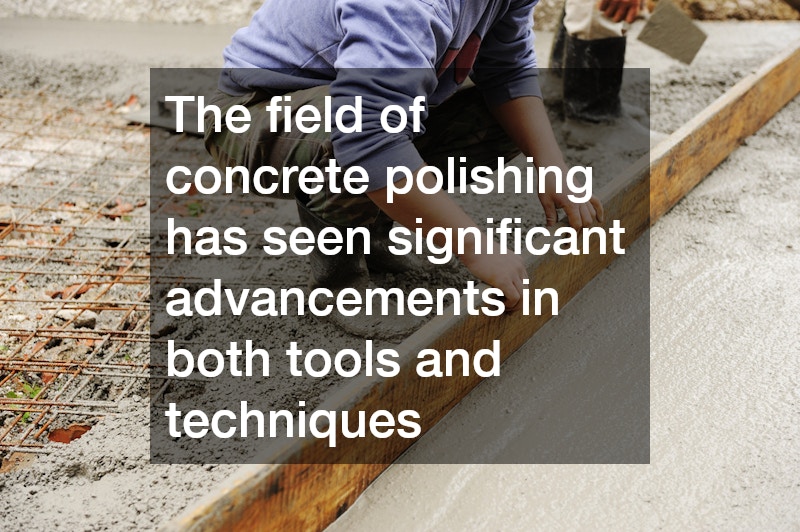Concrete polishing is an evolving field that combines craftsmanship with technology to create stunning finishes. In recent years, the industry has seen a surge of advanced tools and techniques, allowing professionals to achieve remarkable results.
The introduction of new materials and machinery has enhanced efficiency, reduced labor time, and improved the overall quality of polished surfaces. Concrete polishers today have access to a wide range of innovative tools, which has dramatically transformed how they work.
This article delves into the essential tools and techniques used by professional concrete polishers today, providing insight into how the industry continues to evolve and improve.
What Are the Essential Tools for Concrete Polishing?
Grinding Machines
Grinding machines are fundamental to the concrete polishing process, offering various models and sizes tailored for different tasks. Professionals use these machines to level the surface and prepare it for further refining.
Each type of grinding machine serves a specific purpose, allowing concrete polishers to choose the best fit for their project. These machines are equipped with powerful motors and adjustable settings to accommodate different surface conditions.
The efficiency of grinding machines has greatly enhanced the initial phase of concrete polishing, ensuring a smooth and even surface ready for the next steps.
Diamond Abrasives
Diamond abrasives play a critical role in achieving a high-quality polished finish, used extensively throughout the polishing process. These abrasives come in a variety of grits, designed to gradually refine the surface to the desired gloss.
The choice of diamond abrasives impacts the final appearance of the concrete, making their selection a crucial step in the polishing process. As technology advances, new formulations of diamond abrasives continue to emerge, enhancing both durability and performance.
With the right combination of diamond abrasives, concrete polishers can achieve stunning results that highlight the natural beauty of the material.
How Do Polishing Techniques Affect the Final Finish?
Wet vs. Dry Polishing
The choice between wet and dry polishing methods significantly impacts the quality of the concrete surface. Wet polishing involves using water to cool the diamond abrasives and reduce dust, providing a clean and smooth finish.
Conversely, dry polishing offers the advantage of faster completion with less mess, but requires efficient dust collection systems to manage the debris. Both methods have their advantages, allowing professionals to select the best approach based on the project requirements and desired outcome.
Ultimately, the choice between wet and dry polishing influences the final appearance and longevity of the polished concrete.
Steps in Polishing Process
The polishing process involves several steps, each crucial to achieving a flawless finish. Starting with surface preparation, professionals ensure the concrete is free from contaminants and imperfections.
After grinding, the process moves through successive grit levels of diamond abrasives, gradually refining the surface. Finally, the application of a concrete densifier and a protective sealant finish the process, enhancing the durability and appearance of the floor.
Following these detailed steps ensures that the polished concrete not only looks impressive but also stands the test of time.
What Safety Measures Are Required in Concrete Polishing?
Personal Protective Equipment (PPE)
Safety is paramount in the field of concrete polishing, with Personal Protective Equipment (PPE) playing a key role. Professionals are required to wear appropriate gear, including goggles, masks, ear protection, and gloves.
This equipment protects against hazards such as dust, noise, and flying debris, reducing the risk of injury. Adherence to safety protocols ensures the well-being of workers and sets a standard for responsible business practices.
Promoting the use of PPE is an essential aspect of any concrete polishing project, prioritizing safety alongside quality work.
Dust Control Systems
Effective dust control systems are crucial components in the concrete polishing industry. These systems help maintain a clean working environment, minimizing airborne particles that pose health risks.
Dust control measures include vacuum systems integrated with polishing machines or standalone units designed to capture dust at the source. Implementing such systems not only safeguards the health of workers but also ensures compliance with environmental regulations.
The use of advanced dust control technology has become a standard practice, reflecting the industry’s commitment to health and safety.
The field of concrete polishing has seen significant advancements in both tools and techniques, making it a dynamic and innovative industry. From advanced machinery and diamond abrasives to sustainable practices and eco-friendly products, the landscape is constantly evolving.
The commitment to safety, technology, and the environment ensures that the industry remains at the forefront of innovation, meeting the demands of modern construction. As concrete polishers continue to refine their craft, the future looks bright for this transformative and creative field.



